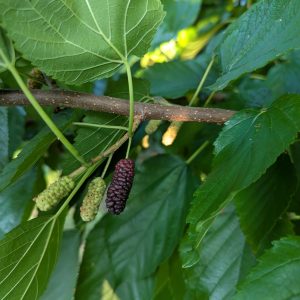Scientific Name: Populus species
Family: Salicaceae (the willow family)
USDA Hardiness Zone: 3-9
Size: 50-80 feet tall
Roots: fibrous, expansive
Growth Rate: very fast
Light: Prefer full sun
Moisture: various
pH: 4-8
Description: Poplars are a great silvopasture tree selection as they are fast growing, cheaply propagated, and their foliage is highly digestible for livestock. Choosing a proper species depends on what your goals are and the area in which you are designing for. Think of them in categories of columnar (windbreaks), aspens (slopes and ridges) and cottonwoods (wet). There are also hybrid varieties to choose from that typically incorporate cottonwood and European genetics. These are known for vigorous growth and producing a harder wood than natives. We typically choose hybrid poplars for fast shade in our plantings.
Main Silvopasture Uses:
- Shade. Quick growing shade, especially when established from tall live stakes. You can use live stakes that are 10’ or more for really fast shade.
- Fodder. Because of low tannins poplars can be considered a staple food for livestock. Abundant and drought-resilient. Willows generally provide more leaf mass, but are higher in tannins, which means their leaves cannot typically be fed at as high of rates.
Other Uses:
- Wood. Biomass, biofuel, paneling, furniture, charcoal. Poplar and willows are often used as fast-growing shade trees in silvopasture, but poplars offer better timber. It’s not high-value hardwood, but can be used for a variety of purposes. For more on this and other topics related to poplars and willows, see the New Zealand Poplar & Willow Trust.
- Erosion control. Fibrous root systems hold the soil together well; extensively used in New Zealand to prevent ‘soil slips’ (mass wasting).
- Logs for forest mushroom cultivation, particularly oyster mushrooms .
Special Considerations:
- Native insects do not eat hybrid poplar leaves and therefore do not support biodiversity as the native species do. Avoid using hybrids for monocultural plantation purposes. Instead use within a diverse planting. If you want native species, consider planting cottonwoods or aspens, depending on your context. Tulip tree, also known as tulip poplar but not an actual poplar, also does well as a native species providing quick shade and higher value timber, though it’s not as cheap to propagate.
- Given how easy and cheap it is to establish poplars, consider using them early on in a silvopasture, so that you can then grow all your own propagation material for your farm and those nearby. Same applies to willows.



